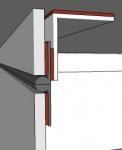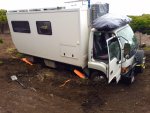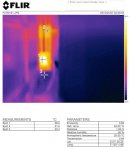You are using an out of date browser. It may not display this or other websites correctly.
You should upgrade or use an alternative browser.
You should upgrade or use an alternative browser.
NPS Camper Build
- Thread starter LeishaShannon
- Start date
LeishaShannon
Adventurer
Our panels are 23mm wide so we used 25mmx25mmx1.6mm aluminium angle powder coated in white.
LeishaShannon
Adventurer
The cupboard doors arrived!

They were CNC cut from 4mm alucobond and taped to stainless steel piano hinge using VHB tape.

The hinge was then stuck to the roof using 25x25x1.6mm angle and a small 24mm wide strip of alucobond was stuck down to make it look alright. Total weight for the 800x300 door, hinge, angle is is under 2kg and the VHB tape is rated to almost 100 times that so hopefully they'll stick up there for awhile
Rather than use traditional latches/catches we're using 500N electromagnets to hold the doors shut during travel.
We have used 2800N "door access control" electromagnets to hold our kitchen drawers in place which have worked really well. There are 6 magnets holding 8 drawers in place and the whole lot draws less than 80 Watts yet has over 1.5ton of holding force.

They were CNC cut from 4mm alucobond and taped to stainless steel piano hinge using VHB tape.

The hinge was then stuck to the roof using 25x25x1.6mm angle and a small 24mm wide strip of alucobond was stuck down to make it look alright. Total weight for the 800x300 door, hinge, angle is is under 2kg and the VHB tape is rated to almost 100 times that so hopefully they'll stick up there for awhile
Rather than use traditional latches/catches we're using 500N electromagnets to hold the doors shut during travel.
We have used 2800N "door access control" electromagnets to hold our kitchen drawers in place which have worked really well. There are 6 magnets holding 8 drawers in place and the whole lot draws less than 80 Watts yet has over 1.5ton of holding force.
Last edited:
Looks like it's coming together nicely. How have you got the electromagnets connected in? Is it only when driving they're active? Have you tested them for heat buildup while active? Like the idea of using them, curious to see how they actually work out.
What's left to do before you're off?
Joe
What's left to do before you're off?
Joe
whatcharterboat
Supporting Sponsor, Overland Certified OC0018
Looks like it's coming ogether nicely. How have you got the electromagnets connected in? Is it only when driving they're active? Have you tested them for heat buildup while active? Like the idea of using them, curious to see how they actually work out.
What's left to do before you're off?
Joe
I've seen electromagnetic catches before. Triggered off the ignition circuit. Very successful.
LeishaShannon
Adventurer
How have you got the electromagnets connected in? Is it only when driving they're active? Have you tested them for heat buildup while active?
They're connected to one of our programmable relays, the onboard computer takes care of when to activate them (either from our iPhone app remote control or automagically when driving)
I'm not sure about the heat build up, I've left them on tonight and i'll pull out the thermal camera for a look in the morning but I wouldn't expect them to get too hot given how little current they draw.
Only a handful of jobs left now... hoping to be finished by end of the month!
LeishaShannon
Adventurer
LeishaShannon
Adventurer
One thing to watch out for is accurate alignment. It might be common knowledge but I had no idea that while these things are super strong when touching they have virtually no pull from just a few mm away, unlike neodymium magnets.
I stuck the door locks to aluminium angle and the angle to the rear of the cabinet wall, then turned on the magnets and placed mild steel flat bar over the magnet in line with where the drawer was. After priming the mild steel and aluminium drawer I then applied liberal amounts of Sika252 and closed the drawer which squashed the glue and ensured a perfect fit. I left the magnets on overnight while the sika set to prevent sag from affecting alignment.
I stuck the door locks to aluminium angle and the angle to the rear of the cabinet wall, then turned on the magnets and placed mild steel flat bar over the magnet in line with where the drawer was. After priming the mild steel and aluminium drawer I then applied liberal amounts of Sika252 and closed the drawer which squashed the glue and ensured a perfect fit. I left the magnets on overnight while the sika set to prevent sag from affecting alignment.
LeishaShannon
Adventurer
Excellent build with a lot of great ideas! I am particularly interested in your domotics system running off your server. Is there a post in here that details that?
Not yet!
We're using a whole bunch of these cards -

http://www.ebay.com.au/itm/8-Channe...-Module-Xbee-Remote-Control-Kit-/221126230067
Everything inside and out is switched via one of these relay boards which are connected together using an Xbee Series 2 industrial radios. These radios are low bandwidth (~250kbps) but very reliable and self-build a mesh network. You can read more about these radios @ http://www.digi.com/products/wirele...oint-multipoint-rfmodules/xbee-series1-module
The input devices (temperature/humidity sensors, reed switches for doors/windows, PIR sensors, fluid flow sensors, physical switches, etc) are connected to arduino micro controllers around the truck which are also fitted with Xbee radios.
The "glue" connecting the inputs and outputs are simple javascript code snippets running as a nodejs application on linux. The app is fairly important as without it nothing works on the truck
We're now running the app on a "OpenWRT" router and an intel NUC which serves double duty as a file server for our movies and Time Machine backups.
By using relatively "dumb" devices (the relay boards / arduinos) and keeping the smarts centralised in the application we're able to replace faulty components quite quickly. It also meant a fairly short "time to leave" as we only had to get the basic programming working to switch lights etc. Now we can work on the extras like switching loads off based on battery SoC, using the flow sensors to predict when we're going to run out of water, using the HWS as a diversion load when we have excess solar, or whatever other ideas I can come up with
From a UX perspective I wanted to keep things as simple as possible so we have 4 physical switches located centrally. These are virtual switches and can be modified to do different tasks based on time of day. At the moment SW1 turns on the kitchen lights, SW2 the bathroom lights, SW3 the water pump, and SW4 does the outside flood lights. The other 100 or so relays are either switched automagically by the software or manually from a simple web application from our iPhones or laptops:

The "Cupboards Soft" functionality is an example of something that wasn't initially planned but was added recently as Leisha didn't like that the cupboard doors were just "hanging" in place. Instead of the full locking voltage being applied to the electro-magnets I lowered them to just ~1.1volts which means they act as a soft latch.
This is a new version of the UI I'm working on:

There is still a lot of functionality to add but the basics are all working well, let me know if you would like any more detail on specific components.
Last edited:
LeishaShannon
Adventurer
It was a bit chilly this morning (1c , -1c apparent) out near lake Clarendon (QLD) so I fired up the AC and set it to 28c @ 5:10am

It took ~ 11 minutes to reach 28c and during this time the AC was pumping ~ 4300W of heat using just over 1100W of electrical energy. Once the set point was reached the electrical usage dropped to an average of just 370W for the next few hours.
It'll be interesting to see how it goes in really cold climates (this unit is rated to -15c) but the initial data looks quite promising as a clean, free and silent alternative to gas/diesel heaters.

It took ~ 11 minutes to reach 28c and during this time the AC was pumping ~ 4300W of heat using just over 1100W of electrical energy. Once the set point was reached the electrical usage dropped to an average of just 370W for the next few hours.
It'll be interesting to see how it goes in really cold climates (this unit is rated to -15c) but the initial data looks quite promising as a clean, free and silent alternative to gas/diesel heaters.
LeishaShannon
Adventurer
Wow, 7 months on the road already. Time for an update!
The truck is going well with no major issues.
The sliding kitchen pantry locking tabs have broken off, the pressed steel drawer slides are supposedly rated at 227Kg but that must be a static load.. not bouncing around the country. The cheap aluminium roof rack also failed.
The Victron power system has performed amazingly, supporting all our HVAC, refrigeration, and cooking loads.
A recent capacity test had the Lithium battery deliver 310Ah (they're rated at 300Ah new..) and still have enough grunt to start the truck even when "empty"
The interior layout works well for two, although Leisha disagreed and this year we have parted ways. (just kidding about the layout, but we have separated)
The electromagnetic cupboard and drawer locks have worked well, except for a minor software bug (my fault) where the drawer locks would randomly unlock during travel. The result was 2 drawers on the floor in the "hall way" and a few scratches. This has now been resolved.
Overall we've both been very happy with the way the truck has performed, keeping us comfortable while visiting some amazing places.








The truck is going well with no major issues.
The sliding kitchen pantry locking tabs have broken off, the pressed steel drawer slides are supposedly rated at 227Kg but that must be a static load.. not bouncing around the country. The cheap aluminium roof rack also failed.
The Victron power system has performed amazingly, supporting all our HVAC, refrigeration, and cooking loads.
A recent capacity test had the Lithium battery deliver 310Ah (they're rated at 300Ah new..) and still have enough grunt to start the truck even when "empty"
The interior layout works well for two, although Leisha disagreed and this year we have parted ways. (just kidding about the layout, but we have separated)
The electromagnetic cupboard and drawer locks have worked well, except for a minor software bug (my fault) where the drawer locks would randomly unlock during travel. The result was 2 drawers on the floor in the "hall way" and a few scratches. This has now been resolved.
Overall we've both been very happy with the way the truck has performed, keeping us comfortable while visiting some amazing places.







Similar threads
- Replies
- 0
- Views
- 682
- Replies
- 2
- Views
- 5K
- Replies
- 64
- Views
- 58K
- Replies
- 2
- Views
- 5K

